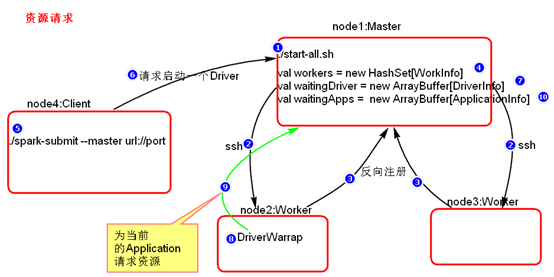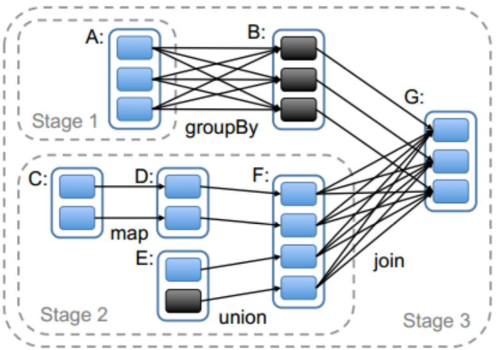- 补充算子
transformations
- mapPartitionWithIndex
类似于mapPartitions,除此之外还会携带分区的索引值。
- repartition
增加或减少分区。会产生shuffle。(多个分区分到一个分区不会产生shuffle)
- coalesce
coalesce常用来减少分区,第二个参数是减少分区的过程中是否产生shuffle。
true为产生shuffle,false不产生shuffle。默认是false。
如果coalesce设置的分区数比原来的RDD的分区数还多的话,第二个参数设置为false不会起作用,如果设置成true,效果和repartition一样。即repartition(numPartitions) = coalesce(numPartitions,true)
- groupByKey
作用在K,V格式的RDD上。根据Key进行分组。作用在(K,V),返回(K,Iterable <V>)。
- zip
将两个RDD中的元素(KV格式/非KV格式)变成一个KV格式的RDD,两个RDD的每个分区元素个数必须相同。
- zipWithIndex
该函数将RDD中的元素和这个元素在RDD中的索引号(从0开始)组合成(K,V)对。
Action
- countByKey
作用到K,V格式的RDD上,根据Key计数相同Key的数据集元素。
- countByValue
根据数据集每个元素相同的内容来计数。返回相同内容的元素对应的条数。
- reduce
根据聚合逻辑聚合数据集中的每个元素。
- PV&UV
- Spark-Submit提交参数
Options:
- --master
MASTER_URL, 可以是spark://host:port, mesos://host:port, yarn, yarn-cluster,yarn-client, local
- --deploy-mode
DEPLOY_MODE, Driver程序运行的地方,client或者cluster,默认是client。
- --class
CLASS_NAME, 主类名称,含包名
- --jars
逗号分隔的本地JARS, Driver和executor依赖的第三方jar包
- --files
用逗号隔开的文件列表,会放置在每个executor工作目录中
- --conf
spark的配置属性
- --driver-memory
Driver程序使用内存大小(例如:1000M,5G),默认1024M
- --executor-memory
每个executor内存大小(如:1000M,2G),默认1G
Spark standalone with cluster deploy mode only:
- --driver-cores
Driver程序的使用core个数(默认为1),仅限于Spark standalone模式
Spark standalone or Mesos with cluster deploy mode only:
- --supervise
失败后是否重启Driver,仅限于Spark alone或者Mesos模式
Spark standalone and Mesos only:
- --total-executor-cores
executor使用的总核数,仅限于SparkStandalone、Spark on Mesos模式
Spark standalone and YARN only:
- --executor-cores
每个executor使用的core数,Spark on Yarn默认为1,standalone默认为worker上所有可用的core。
YARN-only:
- --driver-cores
driver使用的core,仅在cluster模式下,默认为1。
- --queue
QUEUE_NAME 指定资源队列的名称,默认:default
- --num-executors
一共启动的executor数量,默认是2个。
- 资源调度源码分析
- 资源请求简单图

- 资源调度Master路径:

路径:spark-1.6.0/core/src/main/scala/org.apache.spark/deploy/Master/Master.scala |
- 提交应用程序,submit的路径:

路径:spark-1.6.0/core/src/main/scala/org.apache.spark/ deploy/SparkSubmit.scala |
- 总结:
- Executor在集群中分散启动,有利于task计算的数据本地化。
- 默认情况下(提交任务的时候没有设置--executor-cores选项),每一个Worker为当前的Application启动一个Executor,这个Executor会使用这个Worker的所有的cores和1G内存。
- 如果想在Worker上启动多个Executor,提交Application的时候要加--executor-cores这个选项。
- 默认情况下没有设置--total-executor-cores,一个Application会使用Spark集群中所有的cores。
- 结论演示
使用Spark-submit提交任务演示。也可以使用spark-shell
- 默认情况每个worker为当前的Application启动一个Executor,这个Executor使用集群中所有的cores和1G内存。
./spark-submit --master spark://node1:7077 --class org.apache.spark.examples.SparkPi ../lib/spark-examples-1.6.0-hadoop2.6.0.jar 10000 |
- 在workr上启动多个Executor,设置--executor-cores参数指定每个executor使用的core数量。
./spark-submit --master spark://node1:7077 --executor-cores 1 --class org.apache.spark.examples.SparkPi ../lib/spark-examples-1.6.0-hadoop2.6.0.jar 10000 |
- 内存不足的情况下启动core的情况。Spark启动是不仅看core配置参数,也要看配置的core的内存是否够用。
./spark-submit --master spark://node1:7077 --executor-cores 1 --executor-memory 3g --class org.apache.spark.examples.SparkPi ../lib/spark-examples-1.6.0-hadoop2.6.0.jar 10000 |
- --total-executor-cores集群中共使用多少cores
注意:一个进程不能让集群多个节点共同启动。
./spark-submit --master spark://node1:7077 --executor-cores 1 --executor-memory 2g --total-executor-cores 3 --class org.apache.spark.examples.SparkPi ../lib/spark-examples-1.6.0-hadoop2.6.0.jar 10000 |
- 任务调度源码分析
- Action算子开始分析
任务调度可以从一个Action类算子开始。因为Action类算子会触发一个job的执行。
- 划分stage,以taskSet形式提交任务
DAGScheduler 类中getMessingParentStages()方法是切割job划分stage。可以结合以下这张图来分析:

- 二次排序
SparkConf sparkConf = new SparkConf() .setMaster("local") .setAppName("SecondarySortTest"); final JavaSparkContext sc = new JavaSparkContext(sparkConf);
JavaRDD<String> secondRDD = sc.textFile("secondSort.txt");
JavaPairRDD<SecondSortKey, String> pairSecondRDD = secondRDD.mapToPair(new PairFunction<String, SecondSortKey, String>() {
/** * */ private static final long serialVersionUID = 1L;
@Override public Tuple2<SecondSortKey, String> call(String line) throws Exception { String[] splited = line.split(" "); int first = Integer.valueOf(splited[0]); int second = Integer.valueOf(splited[1]); SecondSortKey secondSortKey = new SecondSortKey(first,second); return new Tuple2<SecondSortKey, String>(secondSortKey,line); } });
pairSecondRDD.sortByKey(false).foreach(new VoidFunction<Tuple2<SecondSortKey,String>>() {
/** * */ private static final long serialVersionUID = 1L;
@Override public void call(Tuple2<SecondSortKey, String> tuple) throws Exception { System.out.println(tuple._2); } }); |
public class SecondSortKey implements Serializable,Comparable<SecondSortKey>{ /** * */ private static final long serialVersionUID = 1L; private int first; private int second; public int getFirst() { return first; } public void setFirst(int first) { this.first = first; } public int getSecond() { return second; } public void setSecond(int second) { this.second = second; } public SecondSortKey(int first, int second) { super(); this.first = first; this.second = second; } @Override public int compareTo(SecondSortKey o1) { if(getFirst() - o1.getFirst() ==0 ){ return getSecond() - o1.getSecond(); }else{ return getFirst() - o1.getFirst(); } } } |
- 分组取topN和topN
SparkConf conf = new SparkConf() .setMaster("local") .setAppName("TopOps"); JavaSparkContext sc = new JavaSparkContext(conf); JavaRDD<String> linesRDD = sc.textFile("scores.txt");
JavaPairRDD<String, Integer> pairRDD = linesRDD.mapToPair(new PairFunction<String, String, Integer>() {
/** * */ private static final long serialVersionUID = 1L;
@Override public Tuple2<String, Integer> call(String str) throws Exception { String[] splited = str.split(" "); String clazzName = splited[0]; Integer score = Integer.valueOf(splited[1]); return new Tuple2<String, Integer> (clazzName,score); } });
pairRDD.groupByKey().foreach(new VoidFunction<Tuple2<String,Iterable<Integer>>>() {
/** * */ private static final long serialVersionUID = 1L;
@Override public void call(Tuple2<String, Iterable<Integer>> tuple) throws Exception { String clazzName = tuple._1; Iterator<Integer> iterator = tuple._2.iterator();
Integer[] top3 = new Integer[3];
while (iterator.hasNext()) { Integer score = iterator.next();
for (int i = 0; i < top3.length; i++) { if(top3[i] == null){ top3[i] = score; break; }else if(score > top3[i]){ for (int j = 2; j > i; j--) { top3[j] = top3[j-1]; } top3[i] = score; break; } } } System.out.println("class Name:"+clazzName); for(Integer sscore : top3){ System.out.println(sscore); } } }); |
- SparkShell的使用
- 概念:
SparkShell是Spark自带的一个快速原型开发工具,也可以说是Spark的scala REPL(Read-Eval-Print-Loop),即交互式shell。支持使用scala语言来进行Spark的交互式编程。
- 使用:
启动Standalone集群,./start-all.sh
在客户端上启动spark-shell:
./spark-shell --master spark://node1:7077 |
启动hdfs,创建目录spark/test,上传文件wc.txt
启动hdfs集群: start-all.sh 创建目录: hdfs dfs -mkdir -p /spark/test 上传wc.txt hdfs dfs -put /root/test/wc.txt /spark/test/ wc附件:
|
运行wordcount
sc.textFile("hdfs://node1:9000/spark/test/wc.txt") .flatMap(_.split(" ")).map((_,1)).reduceByKey(_+_).foreach(println) |
